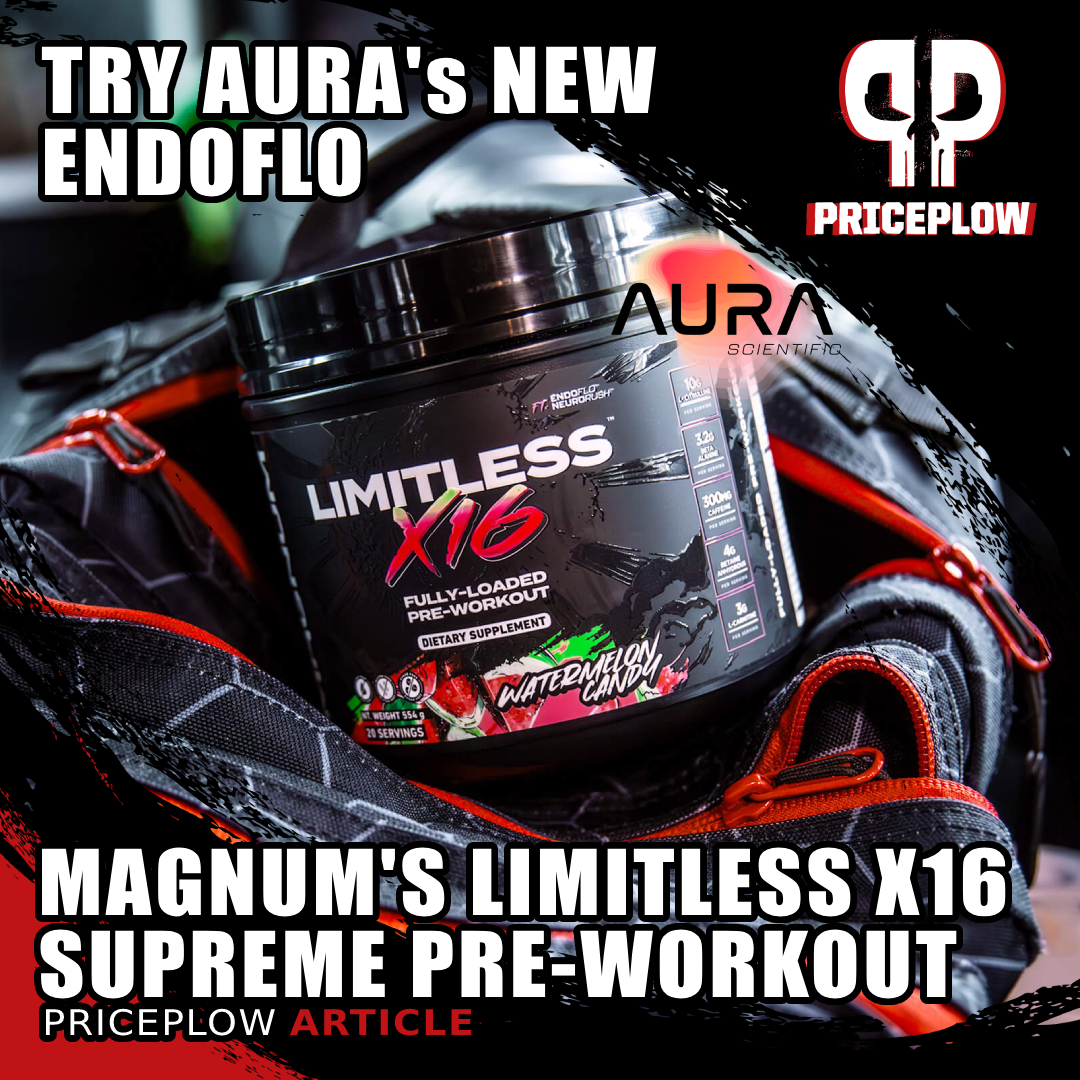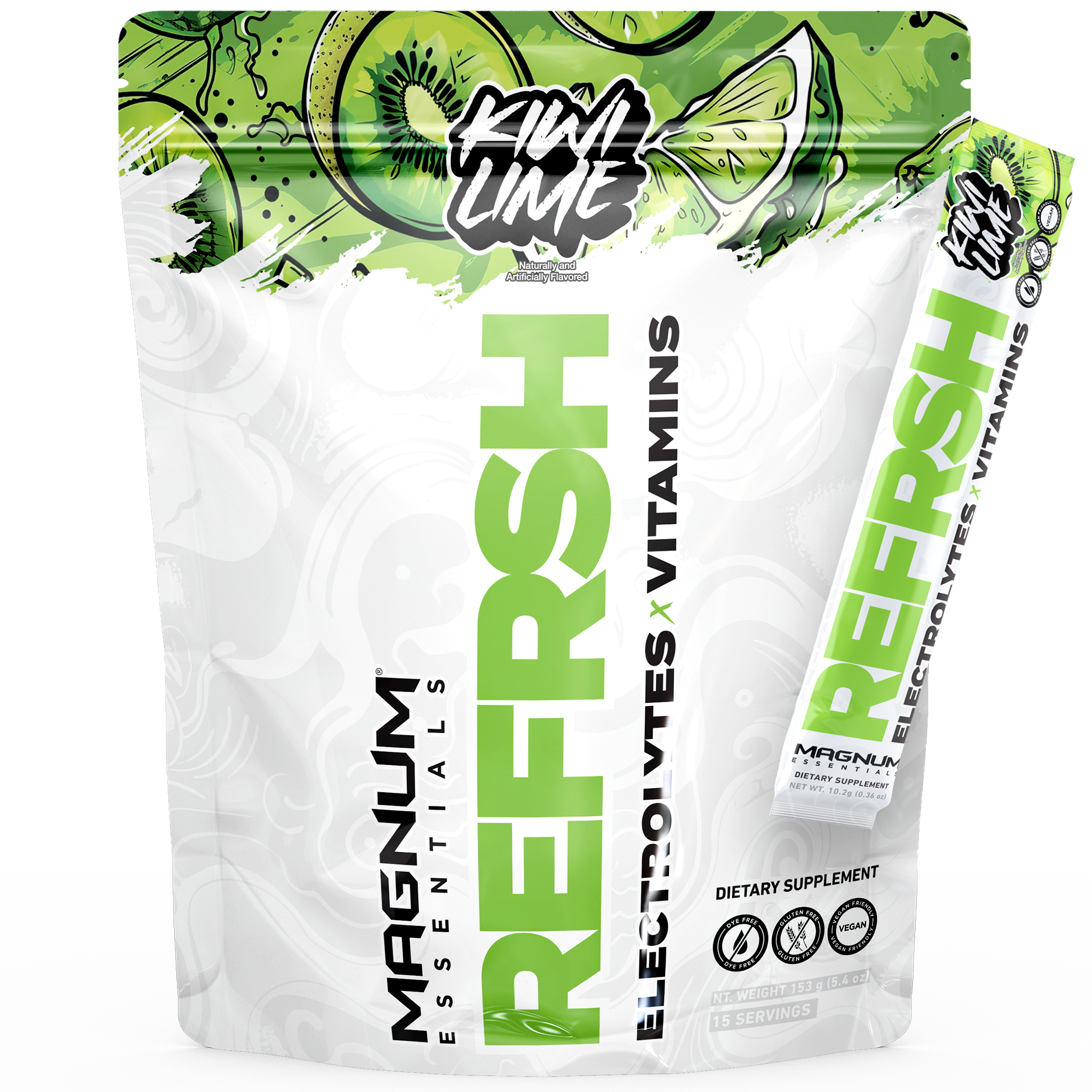The resurgence of Magnum Nutraceuticals, a brand long covered on the PricePlow Blog, is reaching full throttle mode, with yet another new supplement release after their massive Limitless X16 Pre-Workout launch. While Limitless X16 brought two novel ingredients from Aura Scientific in a massive 27 gram scoop, this one's going straight for flavor and simplicity:
Magnum REFRSH: Hydrating Electrolytes with Bold Flavor and Low Price
This go-round, Magnum's entering the popular hydration space, with a relatively straightforward formula that has large doses of sodium and magnesium alongside potassium and reasonable amounts of three B-vitamins.
It's called REFRSH, and the company's going big on flavor, launching stick packs in three varieties that are sweetened by organic cane sugar and sucralose:
- Double Mango
- Water Melon
- Kiwi Lime
Anyone who watches PricePlow knows that we have, well... a thing for mango flavors. So when Magnum decided to double it, we had to try it. Watch our video on what Double Mango may be, and then let's break this formula down line by line.
We also explain why electrolyte supplements should have a bit of carbs inside -- and it's not just for sweetness. But before diving in, sign up for our Magnum Nutraceuticals news alerts, and check availability here:
Magnum Nutraceuticals Refrsh – Deals and Price Drop Alerts
Get Price Alerts
No spam, no scams.
Disclosure: PricePlow relies on pricing from stores with which we have a business relationship. We work hard to keep pricing current, but you may find a better offer.
Posts are sponsored in part by the retailers and/or brands listed on this page.
This area is reserved for Team PricePlow's upcoming videos.
Subscribe to our channel and sign up for notifications so you catch it when it goes live!
Magnum REFRSH Ingredients
Every ~10g packet of REFRSH provides the following:
-
Sodium (as Sodium Citrate and Sodium Chloride) - 500 mg (22% DV)
REFRSH is a sodium-heavy hydration supplement. This critical electrolyte supports proper fluid balance, both in and out of cells.[1] It's essential for muscle contraction and neurotransmission.
Sodium is especially useful for athletes who sweat,[2] since sodium is the most prevalent mineral found in sweat.[3]
Avoiding low sodium (hyponatremia)
As we sweat, it's paramount to not only drink water, but to replace the lost electrolytes.[4] The goal is to avoid hyponatremia -- low sodium, which can be a very dangerous situation.[4,5]
The body will do anything it can to prevent hyponatremia, including using bone (which is high in sodium) to provide the mineral. Long-term bone resorption from low sodium intake can lead to osteoporosis,[6] so we definitely suggest salting food and using mineral supplements when life gets hot and sweaty. This is an ongoing task - not just a once-in-a-while endeavor when you're feeling run down.
But this leads to the question asked by many who follow mainstream media and medical recommendations -- "Isn't too much sodium bad for you?"
How much sodium is too much? More than you think...
Media messaging for decades has repeatedly stated that lower sodium intakes are healthier, and higher sodium intake leads to increased blood pressure. But, as always, media messaging isn't always forthright, and this is the case with the sodium debate as well.
It turns out that too little sodium is just as bad as too much -- but the levels for "too much" are far higher than you've been led to believe. A research review published in 2015, looking at data from over 300,000 individuals, found 3-5 grams of sodium per day is where the lowest risk of deaths and cardiovascular events occur.[7] This is known as a "J-Shaped curve", and is incredibly interesting given the US RDA sitting at a paltry 2.3 grams daily.
Other research has supported this -- in 2011, the Journal of American Medicine published data on over 28,000 individuals showing that sodium intakes under 3 grams per day led to increased risk of heart failure.[8]
Long story short? Sodium is not the enemy, the government's recommendations are too low (especially for athletes), and a lot of people are not getting enough in. It all depends on your diet, but the 500 milligrams in a serving of REFRSH can absolutely help.
Sodium citrate
Worth noting, most of the sodium here is coming from sodium citrate, which helps keep chloride levels low, for those who care. Interestingly, there's a study showing that higher-dose sodium citrate supported improved 3000 meter running performance in elite runners, outperforming the placebo group.[9] It's unclear if standard sodium chloride would have done just as well, but it's still great to see.
Since sodium isn't necessarily always the driving force of cardiovascular issues, what is? It turns out that potassium should be provided as well:
-
Potassium (as Potassium Citrate) - 200 mg (4% DV)
REFRSH is obviously higher in sodium, which is useful for people who sweat or aren't eating much processed food, but Magnum also balances it out a bit with some potassium from potassium citrate.
Potassium is called a shortfall nutrient, since so many North Americans simply don't get enough.[10,11] There's not much research on potassium supporting sports performance -- most of it's related to cardiovascular health.[10]
In terms of health in the average citizen, we repeatedly see that sodium excess isn't necessarily the enemy, but low potassium is![11,12] The sodium-potassium interaction and ratio is far more critical in supporting healthy blood pressure.[13-18] And one important benefit for everyone is that potassium can improve calcium retention, leading to improved bone mineral density.[19,20]
For athletes, it's also important to know that potassium supports vasodilation, by stimulating the sodium pump and opening potassium channels.[13,21,22]
While this isn't a massive dose of potassium, it can certainly help -- we'll basically take potassium anytime, anyplace.
-
Magnesium (as Magnesium Citrate) - 170 mg (40% DV)
Aside from the large dose of sodium, Magnum also goes big on magnesium, which is another critical shortfall nutrient we're not getting enough from our food or water supplies these days.[23] This 170 milligram yield is one of the bigger one we've seen in an electrolyte supplement from a sports nutrition brand.
Magnesium is used in countless biological processes -- it's an electrolyte valuable for energy transfer and fluid balance, but it's also a cofactor in a ton of our body's biochemical reactions. Athletes will appreciate that a lot of those reactions involve ATP and energy production.[24]
On the cardiovascular side magnesium also supports reduced blood pressure.[25-28] On the metabolic side, those who are deficient can improve their blood sugar levels and insulin sensitivity with it.[25,29,30]
And on the athletic side, one study showed better muscle oxygenation and aerobic exercise capacity in triathletes who supplemented magnesium.[31]
Magnesium is also well-known for its ability to support better sleep and reduced anxiety.[32,33]
Finally, we've seen better bone mineral density from the cheapest form of magnesium (magnesium oxide),[34] so we believe magnesium citrate will help there as well.
Long story short, Magnum REFRSH has so much magnesium, you can almost consider this a magnesium supplement in its own right. If you take a separate magnesium supplement, you likely won't need a full 100% DV dose now!
-
Sweetening Blend: Organic Cane Sugar and Sucralose
Before getting into the vitamins, it's important to note that we have 5 grams of carbohydrates, including 3 grams of organic cane sugar (and what's provided in the flavor systems). First, this is a supplement that goes for flavor, and you simply won't beat the cane sugar + sucralose combination.
But more importantly, as the hydration craze has gone on, we've begun discussing how carbohydrates play a significant role in enhancing hydration and electrolyte absorption. This is due to the principle of co-transport, where glucose and sodium are absorbed together in the intestines, driving water absorption alongside. This is thanks to the sodium-glucose cotransporter SGLT1 in the small intestine.[35,36]
We are hopefully beyond the point of anyone fearing 12 calories from sugar -- do not let some sweet carbs stop you from achieving proper sodium uptake!
-
Vitamin B6 (as Pyridoxine HCl) - 2.3 mg (135% DV)
Vitamin B6 plays an important role in energy metabolism, aiding in the conversion of food into energy. It supports neurotransmitter synthesis, enhancing cognitive function and mood, which can be beneficial during intense physical activity.
Vitamin B6 is also involved in hemoglobin production, improving oxygen transport in the blood, so it may support endurance and recovery. We're generally not too concerned with its deficiency these days, so we don't need a massive dose like we sometimes see.
-
Vitamin B12 (as Methylcobalamin) - 6.8 mcg (283% DV)
Similarly, vitamin B12 is essential for energy production, helping convert carbohydrates into glucose. It also supports red blood cell formation, again supporting oxygen delivery to muscles, while aiding in nerve function.
Methylcobalamin is the methylated form that we prefer over cyanocobalamin, and this is a vitamin that vegans and vegetarians definitely need to look into if they're not eating meat.
-
Pantothenic Acid (as Calcium Pantothenate) - 11 mg (228% DV)
Sometimes known as vitamin B5, Pantothenic Acid is essential for converting carbohydrates, fats, and proteins into energy. It supports the synthesis of coenzyme A, vital for metabolic processes. It also aids in the production of hormones and neurotransmitters. Finally, it plays a role in the synthesis of red blood cells, supporting overall cellular health.
Flavors Available
Magnum REFRSH launched in three flavors, and we were especially excited for the Double Mango flavor. Here's a list of everything available now:
Conclusion: Affordable Hydration Stick Packs with Flavor

Magnum Nutraceuticals Limitless X16 pre-workout is on the next level with Aura Scientific's EndoFlo for mind-blowing pumps, NeuroRush for added energy and laser focus, and so much more.
REFRSH is a great, simple follow-up to Limitless X16, and the two can definitely be stacked one after another. Going big on sodium and magnesium, it's going to be supportive of athletes who are either sweating a lot or not eating much processed food -- which should hopefully be a lot of our readers.
But even better than going big on sodium and magnesium is the big flavor. With one of our favorite mango electrolyte supplements nearing extinction, it was perfect timing for someone to take on the mango throne, and Magnum did it with a Double Mango flavor - almost as if they spied on our social media and knew exactly what we'd want!
So today's lesson learned? Don't avoid the salt - especially if you're sweating much. Replenish it with REFRSH.
Magnum Nutraceuticals Refrsh – Deals and Price Drop Alerts
Get Price Alerts
No spam, no scams.
Disclosure: PricePlow relies on pricing from stores with which we have a business relationship. We work hard to keep pricing current, but you may find a better offer.
Posts are sponsored in part by the retailers and/or brands listed on this page.











Comments and Discussion (Powered by the PricePlow Forum)